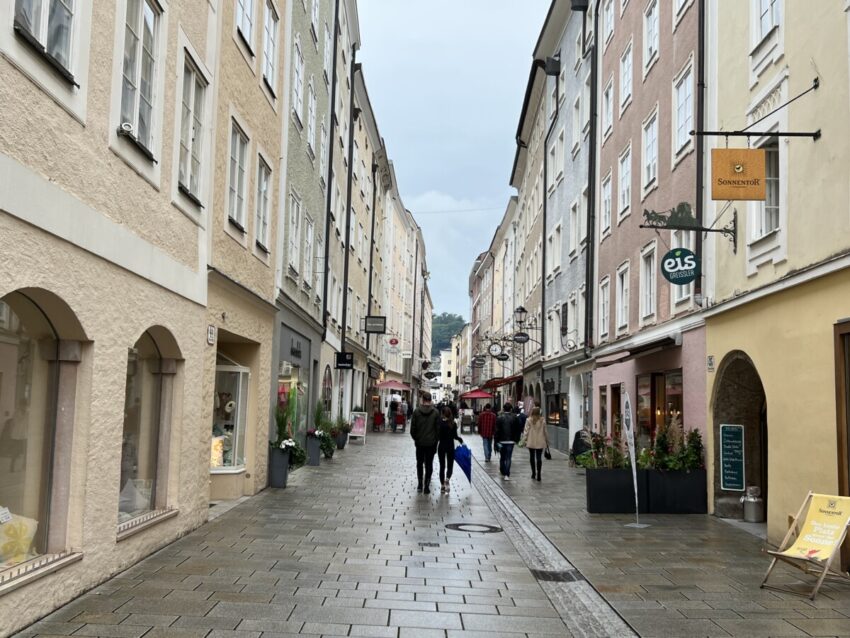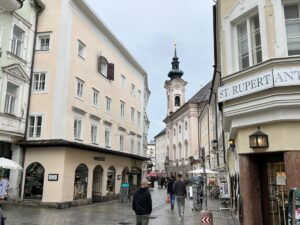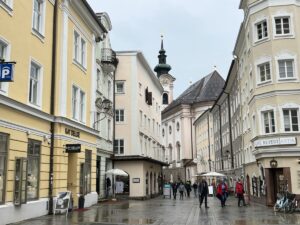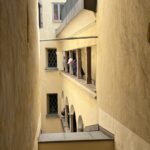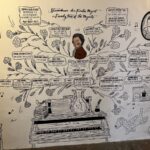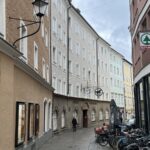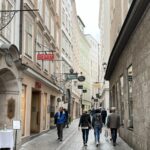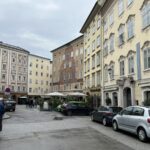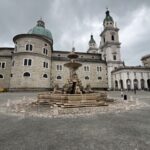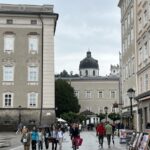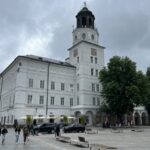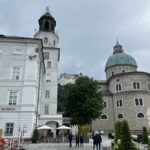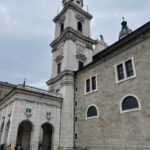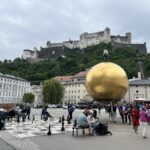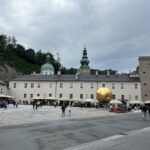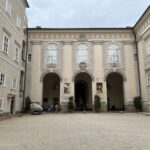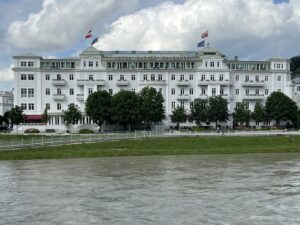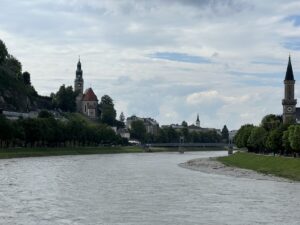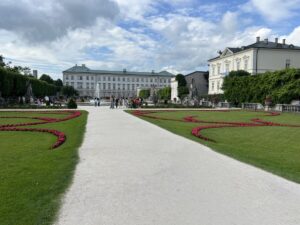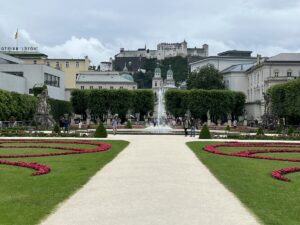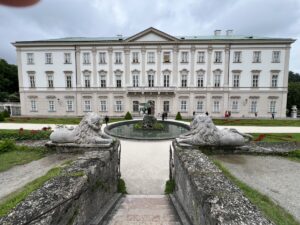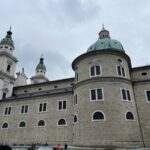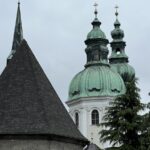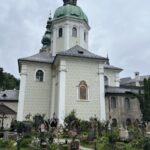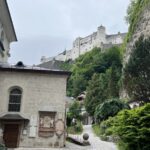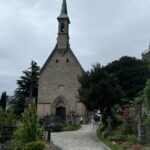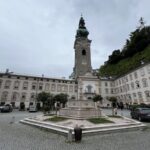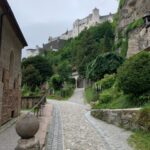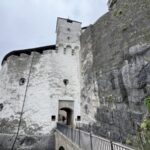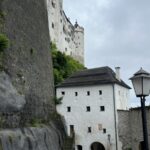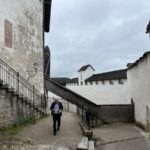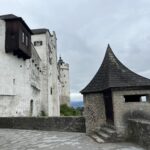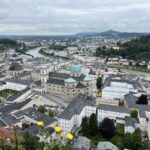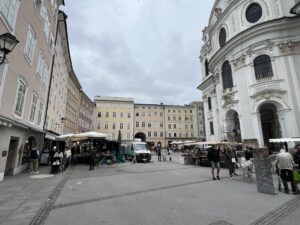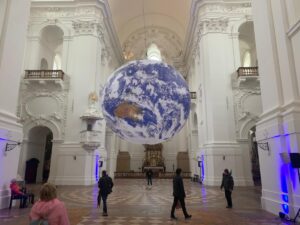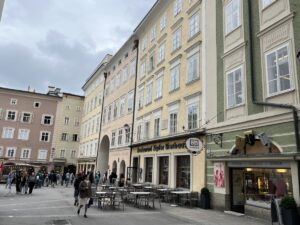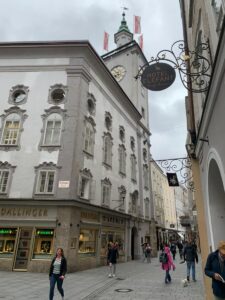We arrived in Salzberg to our lovely boutique hotel, the Hotel and Villa Auersperg, situated in the new town of Salzburg. What a lovely place to relax with such friendly and helpful staff. Such a change to the previous hotel in Schonau. We started off strolling through the new town of Salzburg and then crossed the river to the old town.
Salzburg is an Austrian city on the border of Germany, with views of the Eastern Alps. The city is divided by the Salzach River, with medieval and baroque buildings of the pedestrian Altstadt (Old City) on its left bank, facing the 19th-century Neustadt (New City) on its right. The Altstadt birthplace of famed composer Mozart is preserved as a museum displaying his childhood instruments. A tour of Mozart’s birthplace in the old town is definitely worth a visit. Information on Wolfgang Mozart is as follows:-
Wolfgang Amadeus Mozart (1756-1791) was born on 27 January 1756. His father discovered his extraordinary musical talent at an early age and he knew best how to encourage it. At the age ot five Wolfgang could already play the violin and piano. In 1761 he performed in public for the first time and one year later his father embarked with him on the first of several concert tours in order to make the child prodigy well known in Europe.
At the age of eight Wolfgang wrote down his own first compositions himself; he composed his first work for the stage at the age of eleven.
From 1769 to 1773 he celebrated great successes in Italy. At the age of sixteen he was appointed concert master of the Salzburg court orchestra. In 1777 he first requested permission from Prince-Archbishop Colloredo to leave the orchestra so that he could again travel. Mozart hoped to be appointed as a composer at one of the great European royal courts. The attempt failed, he returned to Salzourg and was given an appointment as court organist.
in 1781, at the age of twenty-five Wolfgang broke away finally from his employer and settled in Vienna. One year later he married Constanze Weber. The couple had six children, of whom only two sons lived to adulthood. In 1787 Joseph Il appointed Mozart as Imperial and Royal Chamber Musician.
Wolfgang lived until his death in 1791 as a freelance composer, pianist and music teacher
Wolfgang Amadeus Mozart spent about one third of his life, in fact 3,720 days travelling. In the 35 years of his life he composed over 600 musical works, including 22 operas.
“A phenomenon such as Mozart always remains a miracle that cannot be explained further” (Johann Wolfgang von Goethe, 1831)
We continued on around the old town admiring the buildings and little laneways. We went in to the Salzburg Cathedral and also to the Domquartier Museum. Of its numerous churches, the cathedral is Salzburg’s most important sacred building. With its mighty dome and two towers the cathedral is very much the centerpiece of Salzburg. Destroyed by fire and rebuilt, enlarged and expanded, it bears witness to the power and independence of Salzburg’s archbishops.
The cathedral is part of Residenzplatz known as Residence Square. It is an especially magnificent forecourt between the archiepiscopal residences in the heart of Salzburg’s Old City. It is bordered by the New Residence with its carillon, the Cathedral, the Old Residence and a continuous row of townhouses.
The DomQuartier comprises the historical centre of political and ecclesiastical power of the Salzburg Prince-archbishops. The museum complex, consisting of the Residenz, Cathedral and St Peter’s Archabbey, forms the baroque heart of the Salzburg UNESCO World Heritage Site. Over centuries, the Old Residenz was the official seat and prestigious headquarters of the prince-archbishops. The state-rooms reflect two centuries of art and design history, from the Renaissance through the Baroque, to Classicism. In addition, they are an authentic experiential place in Salzburg’s musical history: The first opera north of the Alps was performed in the Carabinierisaal. Wolfgang Amadé Mozart gave his first Salzburg court concert in the Konferenzzimmer at the age of seven. As court musician to the prince-archbishop, he composed for these rooms and performed in them himself – they were, along with the cathedral, his immediate sphere of professional activity.
The site of the Mirabell Palace and the Mirabell Garden are under a preservation order and belong to the UNESCO World Heritage list. Prince-Archbishop Wolf Dietrich von Raitenau had the Palace (originally called Schloss Altenau) built in 1606 for his mistress Salome Alt and their 15 children. His successor, Marcus Sittikus, banished mother and children from the palace, which he re-named “Schloss Mirabell” [from the Italian mirabile “wonderful” and bella “beautiful”]. Eventually, under Prince-Archbishop Franz Anton Harrach, the site was reconstructed as a baroque palace complex.
Today, the Mirabell Palace houses the offices of the Salzburg mayor and the municipal administration. Mirabell Palace is also known for the fact that Leopold Mozart and his children Wolfgang and Nannerl performed here.
On our second day in Salzburg we went up to the Hohensalzburg Fortress. The views looking out over Salzburg are spectacular even when it is dull and overcast! Hohensalzburg Fortress is a large medieval fortress in the city of Salzburg, Austria. It sits atop the Festungsberg mountain at an altitude of 506 m. It was erected at the request of the prince-archbishops of Salzburg. The fortress is 250 m long and 150 m wide making it one of the largest medieval castles in Europe. Archbishop Gebhard built the Hohensalzburg Fortress in 1077. In the following years, his successors were responsible for the further development of the fortress architecture. Around 1500, under Archbishop Leonhard von Keutschach, the fortress took on its present appearance. The original purpose of the fortress was to protect the principality and the archbishops from enemy attack. In all these years it has never been taken by foreign troops.
Our last stop for the day was the Collegiate Church, located in University square, which is the church of the university of Salzburg. Currently there is one of the most sensational art installations of recent years for the first time in Austria in the church. The central dome of the Kollegienkirche is the setting for the three-dimensional image of the seven-metre diameter globe. British artist Luke Jerram created the rotating artwork as a reflection of current social events and challenges. The installation features detailed NASA images of the Earth’s surface and is 1.8 million times smaller than the real Earth, with each centimetre of the internally illuminated sculpture representing 18 km of the Earth’s surface.
And so our time in Salzburg has come to an end. A wonderful few days with my friend Geoff who is very patient and understanding with someone as mad as myself!!!! Back to the UK tomorrow with good old Wizzair!

